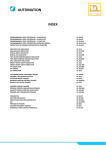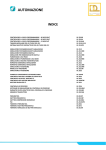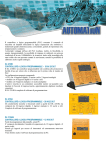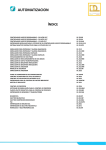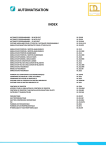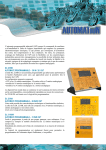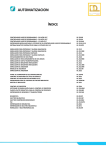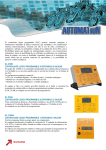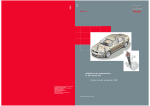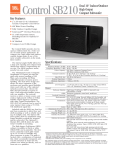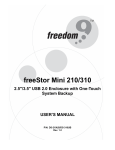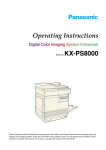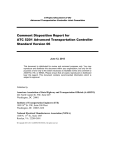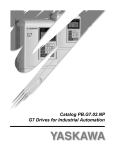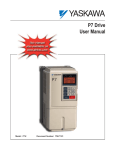Download DL 2122RM - Green PCB Tronics Co.,Ltd.
Transcript
the PLC the Interactive Training Systems the Electric Controls the Simulators the Process Controls the Pneumatics and the Hydraulics Table of Contents PAGE CODE DESCRIPTION page 4 DL 2110B Programmable Logic Controller - 38 IN/34 OUT page 4 DL 2110A Programmable Logic Controller - 24 IN/16 OUT page 4 DL 2110AH Programmable Logic Controller - 12 IN/8 OUT page 5 DL 2110-131K Programmable Logic Controllers Modular Trainer THE PLC THE INTERACTIVE TRAINING SYSTEM page 6 DL 2110ITS Interactive PLC Trainer for Industrial Processes page 7 DL 2110RTIS Simulation Software for Road Traffic Information Sistem THE SIMULATORS page 8 DL 2112 Analogue Input/Output Simulator page 8 DL 2112RM Analogue Input/Output Simulator page 8 DL 2113 Digital Input Simulator page 8 DL 2113RM Digital Input/Output Simulator page 9 DL 2120 Two-Floor Parking Garage Simulator page 9 DL 2120RM Two-Zone Parking Garage Simulator page 9 DL 2124 Belt Conveyor Simulator page 10 DL 2121 Smart Traffic Lights Simulator page 10 DL 2121RM Smart Traffic Lights Simulator page 10 DL 2122RM Lift Simulator page 11 DL 2122M Lift Model page 11 DL 2122 Lift Simulator THE ELECTRIC CONTROLS page 12 DL 2104G Electromechanic Component Board page 12 DL 2123 Squirrel Cage Motor Control page 13 DL 2125 DC Motor Speed Control page 13 DL 2126B Didactic System for Servo-Motor Control Study page 14 DL 2127B Didactic System for Electric Machines Control Study with Frequency Inverter and Electrodynamic Brake page 15 DL 2128B Didactic System for Electric Machine Control Study with Static Start Key/Soft Starter page 15 DL 2129B Didactic System for Step Motor Control Study THE PROCESS CONTROLS page 16 DL 2314 Process Control Trainer page 17 DL 2314S Process Measurement and Control System page 18 DL 2314BR Didactic Process Control Pilot Plant page 19 DL 2312HG Sensor and Transducers Trainer THE PNEUMATICS AND THE HYDRAULICS page 20 DL 8110P Pneumatics page 21 DL 8115EP Electro-Pneumatics page 21 DL 8110SLZ Air Compressor page 21 DL 2110ATN Programmable Logic Controller - 24 IN/16 OUT page 24 DL 8161 Pneumatic Trainer page 24 DL 8171 Electro-Pneumatic Trainer page 25 DL 8110H Hydraulics Automation INTRODUCTION Automation is the use of control ol asystems to control industrial maCss chinery and processes and PLCs play a main role in this field. This is why our Automation laboratory ryy starts from the study of PLCs, to allow ow w students the analysis and the acqui-sition of the techniques related too programming a PLC and to its use in control technology. The catalogue continues with the presentation i off all ll the h applications that we have designed to facilitate, in a user-friendly and stimulating way, the work of teachers and students, through simulation panels or models, virtual environments or pilot plants, teaching systems with real equipment, all adapted to the didactic purpose of representing an efficient and effective learning tool. The catalogue then introduces the subject of Process Control through trainers reproducing real industrial situations and is completed by our Pneumatics, Electro-pneumatics, Hydraulics and Electro-hydraulics work benches. To solve an automation problem, the student must have a remarkable range of knowledge, which goes from electrical engineering to electronics, from information technology to mechanics and communications. The aim of this laboratory is to provide tools that combine the above domains, in order to provide students with the most up-to-date automation technologies, stimulating and fascinating them with an original methodology of study. For this reason, the student is taught, through handbooks provided with the equipment, the basic knowledge to be able to autonomously find the best solution of the problems. Currently, for manufacturing companies, the purpose of automation has shifted from increasing productivity and reducing costs, to broader issues, such as increasing quality and flexibility in the manufacturing process. We believe that our didactic equipment represent a substantial contribution to the fulfilment of the aforesaid objectives. the PLC The programmable logic controller (PLC) allows controlling machines and installations by using the sequential logic that replaces the traditional electromechanical boards, allowing, therefore, to save relays, timers and counters. Moreover, the main advantages in the use of the PLC are the flexibility, because they can be re-programmed, the industrial characteristics, thanks to the possibility of their use in environments with heavy working conditions, the reliability and the safety, typical of the solid state technology that has no moving contacts, as well as the possibility to process analogue signals. DL 2110B DL 2110B PROGRAMMABLE LOGIC CONTROLLER – 38 IN/34 OUT The DL 2110B unit is a programmable controller that combines high performances and ease of use for those who are approaching for the first time the world of PLC. The proposed configuration includes: • CPU with 24 digital inputs and 16 relay outputs • module with 8 digital inputs and 8 relay outputs • module with 8 digital outputs (transistor) • 2 modules with 3 analogue inputs and 1 analogue output each The unit is fitted in an accessible container while on the panel the input/output terminals are shown, suitably duplicated by means of connectors. The DL 2110B is complete with the programming software. DL 2110A DL 2110A 211 11 10A 0A PROGRAMMABLE LOGIC CONTROLLER – 24 IN/16 OUT This unit has technical and functional characteristics similar to the ones of the DL 2110B, but it is composed of the CPU only with 24 digital inputs and 16 relay outputs. Complete with the programming software. DL 2110AH PROGRAMMABLE LOGIC CONTROLLER – 12 IN/8 OUT DL 2110AH 0A AH 4 De Lorenzo Group Easy to be programmed from its own panel, without computer. It is composed (including the extension module) of 12 digital inputs and 8 relay outputs. Simulation of the inputs through switches and externally through terminals. The programming software is also supplied to allow programming the PLC from the computer, if so preferred. DL 2110-131K PROGRAMMABLE LOGIC CONTROLLERS MODULAR TRAINER This modular trainer allows the study of PLC and/or MMI. The modular panel is a tubular steel structure, treated with electrostatic painting, dimensions: w= 660 mm, h=935 mm, d=350mm. It has 4 lines for manual and fast fixation of the modules without the need for tools. Each module is made of steel plate, treated with electrostatic painting. All terminals and connection points are available through 2 or 4 mm terminals (according to the voltage). The dimensions of the modules are 200 x 110 mm. or multiples. The components, as well as their terminals and access points, are identified with the respective symbol printed in silk-screen. • PLC module: a Programmable Logic Controller with integrated Man-MaMa ing chine Interface (MMI) and liquid crystal display. It includes the programming ital software. Configuration: 8 transistor digital inputs (24 Vdc), 6 transistor digital dc), outputs (24 Vdc), 4 analogue inputs (0-10 Vdc), 1 analogue output (0-10 Vdc), 1 pulse fast counting input (4 kHz). All of the inputs and outputs are accessible ble through 2 mm terminals and identified with symbol in silk-screen. • Input power module, with protection switch and lights. Power supply: single-phase from mains. • Power supply module with polarity inversion and over-current protection. Outputs: 12 Vdc, 24 Vdc and 0 ÷ 24 Vdc. • Module with switches for digital input signals simulation. It includes 8 fixed contact switches with retention, NC/NO, for simulating the logic levels. tact • Module with switches for digital input signals simulation. It includes 8 contact pulse switches, NC/NO. • Module with switches for digital input signals simulation. It includes 4 contact tact pulse switches, NC/NO and 4 contact retention switches, NC/NO. • Module with 8 led for light indication of output digital signals, suitable for PLC with NPN or PNP outputs. • Module with 2 linear potentiometers for simulation of voltage or current signals (4 to 20 mA and 0 to 12 Vdc). • Module for analogue signals measurement. Possibility to measure 2 signals simultaneously. One of the inputs is suitable for current signals from 4 to 20 mA and the other for voltage signals from 0 to 10 Vdc. • Module with step motor, with 4 bits electronic driver, with light indication for each bit. • Module with 4 relays for 10 A and 24 Vdc coil, suitable for PLC with NPN or PNP outputs. • Module with DC motor and encoder, suitable for PLC with NPN or PNP inputs. • Module with Analogue/Digital converter. 4 bits A/D converter, with analogue signals input from 0 to 5 Vdc / 0 to 24 Vdc and output from 4 to 20 mA and 4 bits in 24 Vdc. • Module for Digital/Analogue converter. 4 bits D/A converter, with maximum analogue output signals adjustable from 5 to 24 Vdc and from 4 to 20 mA and 4 bits from 5 to 24 Vdc input. Supplied with a set of 30 connection cables, 2 and 4 mm, and an experiment manual. DL 2110-13 2110-131K 21102110 21 13 31 1K K De Lorenzo Group 5 the Interactive Training Systems DL 2110ITS INTERACTIVE PLC TRAINER FOR INDUSTRIAL PROCESSES The DL 2110ITS is a training tool for PLC programming, that uses a PLC SIEMENS (SIMATIC S7-200 or S7-300 series) and an interactive educational software for the simulation of industrial environments to be controlled. HOW DOES IT WORK? DL 2110ITS-200 The DL 2110ITS offers five virtual industrial processes to learn how to program a PLC, with real situations of sorting, batching, palletizing, pick and place and automatic warehousing. Each process reproduces the visual simulation of an industrial situation, including virtual sensors and actuators, so that the state of the system is “sensed” and controlled by the PLC: The objective is to program the PLC to control each of the five virtual processes as if they were real systems. The information is exchanged between the PLC and the virtual system through a data acquisition board (DAQ) provided with 32 I/O isolated channels and USB interface. MAIN FEATURES • PLC Siemens of the SIMATIC S7-200 or S7-300 series • 3D realistic graphics • Real-time physics that closely emulates what happens in real life • 3D real-time sound • Total interactivity with the systems • Friendly user interface • Easy and fast to setup Based on the latest PC technology, the DL 2110ITS makes PLC training easy and fun. Virtual environments have never been so real, featuring cutting-edge 3D real-time graphics, sound and total interactivity. The result is an immersive simulated environment that allows highly realistic training processes, without any risk of injury to man or damage to machines. The automation tasks are presented with increasing levels of difficulty, so that users can progress to more advanced exercises as they improve their skill. REAL WORLD BASED TRAINING SYSTEM DL 2110ITS-300 The DL 2110ITS presents five training processes based on real world industrial scenarios. Each process offers standard problems found in PLC programming, presented in order of increasing level of difficulty. DESCRIPTION OF THE PROCESSES SORTING: transport cases from the entry bay to the elevators, sorting them by height BATCHING: mix three primary colors (red, green and blue) in order to obtain a desired color PALLETIZER: palletize cases up to three layers PICK & PLACE: place parts inside boxes through a three axes manipulator 6 De Lorenzo Group AUTOMATIC WAREHOUSE: transport, store and retrieve boxes from a rack FAULT SIMULATION The DL 2110ITS allows you to simulate failures in sensors and actuators. These failures can be in open circuit or short-circuit. With this feature the user is able to induce malfunctions in the system, presenting new challenges and increasing the realism of the simulation. INTERACTIVITY • Interact with the system as you would in a real system • Add and remove objects from the production circuit, at any time during the simulation • Cause error situations or system jams • Test individual parts of the system; for example: test a conveyor table DL 2110RTIS SIMATIC S7-200 CPU 226 AC/DC/Relay 24 digital inputs 16 digital outputs PC/PPI USB programming cable STEP 7 MicroWIN DE LORENZO code: DL 2110ITS-200 SIMATIC S7-300 CPU 312C Additional module SM 323 18 digital inputs 14 digital outputs Power supply PS 307 24VDC/2A Micro Memory Card 64kByte USB PC-adapter for the connection PC/PLC 480 mm. guide STEP 7 Lite Simulation area with micro-switches and terminals DE LORENZO code: DL 2110ITS-300 SIMULATION SOFTWARE FOR ROAD TRAFFIC INFORMATION SYSTEMS DL 2110RTIS is a simulation software for the understanding of the operations of a Road Traffic Information System and for PLC programming. A simulated operations environment can be interfaced with real equipment for controlling the simulation. The virtual system is a visual simulation of a Road Traffic Information System, including virtual sensors and actuators, so its state can be sensed by the PLC. The objective is to program the PLC to control the virtual system as if it was a real system. For those that are interested only in the operation of the Road Traffic Information System, to learn how it works and what can be done with it from the functional point of view, this product can be used in manual mode, that is, without the need for programming the PLC, and the student can practice in using and controlling the Road Traffic Information System as if he was in the control room of a traffic management company. It includes: realistic graphics of a Road Traffic Information System for the study of road traffic, traffic conditions and display of traffic safety messages on warning signs, a simulated graphical display module, to memorize more than 10 road traffic signs, a simulated alphanumerical display module with capacity to store up to 20 messages, a simulated radar module, the control and programming system. It allows you to simulate failures in the system. NOTE: this software is an optional application for the DL 2110ITS system. De Lorenzo Group 7 the Simulators DL 2112 ANALOGUE INPUT/OUTPUT SIMULATOR The simulator is essential and indispensable for operation and understanding of the analogue modules of the PLC. The board includes 2+2 inputs, at 4-20 mA and 0-10 V respectively, and 4 outputs at 4-20 mA/0/1-5 V, smoothly variable through potentiometer; the current/ voltage display is of digital type; the input indication is of bar type, through meters that can be switched. Moreover, 4 outputs at 24 Vdc/1 A are available, internally powered. The connection to the PLC can be carried out through terminals or connector. Power supply: single-phase from mains. Complete with connecting cables, educational manual and software. NOTE: It can be connected to a PLC such as the DL 2110B. DL 2112 DL 2112RM ANALOGUE INPUT/OUTPUT SIMULATOR DL 2112RM It includes 1+1 inputs, at 4-20 mA and 0-10 V respectively, and 1+1 outputs at 4-20 mA/0-5 V, smoothly variable through potentiometer; the current/voltage display is of digital type. The connection to the PLC can be carried out through terminals. Power supply: single-phase from mains. Complete with connecting cables, educational manual and software. NOTE: It can be connected to a PLC such as the DL 2110B. DL 2113 DIGITAL INPUT SIMULATOR DL 2113 (on the left, PLC not included) The simulator allows studying and analyzing the programming techniques through automatisms which are freely and imaginatively implemented. Moreover, it allows the PLC potentialities to be pointed out. The board includes 32 switches on 4 columns for PLC input enabling, with a LED signalling the on/off state of the individual switch and the possibility of marking the references on special tags that can be cancelled; moreover, 4 outputs at 24 Vdc/1 A are available, internally powered. The connection to the PLC can be carried out through terminals or connector. Power supply: single-phase from mains. Complete with connecting cables, educational manual and software. NOTE: It can be connected to a PLC such as the DL 2110A or DL 2110B. DL 2113RM DIGITAL INPUT/OUTPUT SIMULATOR DL 2113RM 8 De Lorenzo Group It includes 8 switches for PLC input and 8 LED for PLC output. The connection to the PLC can be carried out through terminals. Power supply: single-phase from mains. Complete with connecting cables, educational manual and software. NOTE: It can be connected to a PLC such as the DL 2110AH. DL 2120 TWO-FLOOR PARKING GARAGE SIMULATOR The system represents a two-storey parking garage where it is possible to realistically simulate all the sequences that a car driver has to perform when he wants to use an automated parking garage. The automatic control is performed through a PLC, whose program manages the displays signalling vacant and full places, both at the entrance and at every floor, the opening and closing of the in and out barriers, the lighting intensity at each floor, regulated by the presence of at least one car detected by special sensors, and the smoke and fire detectors. The number of cars in the parking garage is displayed through LED, whose control is assigned to an electronic circuit separated from the PLC. Complete with connecting cables, educational manual and software. Power supply: single-phase from mains. NOTE: It can be connected to a PLC such as the DL 2110A or the DL 2110B. DL 2 2120 120 12 0 DL 2120RM TWO-ZONE PARKING GARAGE SIMULATOR It represents a two-zone parking garage where it is possible to realistically simulate the sequences that a car driver has to perform when he wants to use an automated parking garage. The automatic control is performed through a PLC, whose program manages the displays signalling vacant and full places for both zones and the opening and closing of the in and out barriers. The number of cars in the parking garage is displayed through LED. Complete with connecting cables, educational manual and software. Power supply: single-phase from mains. NOTE: It can be connected to a PLC such as the DL 2110AH. DL 2120RM 212 120 0 DL 2124 BELT CONVEYOR SIMULATOR The board allows simulating the transfer of material. The system of rolls used for the transport, the loading and the accumulation of material are simulated by means of LED. Test signals are available, such as: • wrong programming indicator • limit switch closing indicator • optical-acoustic indicator for alarms • motor overload indicator Besides the automatic control carried out through the PLC, it is possible to manually carry out all the operations. The system is complete with educational manual. Power supply: single-phase from mains. NOTE: It can be connected to a PLC such as the DL 2110A or the DL 2110B. DL 2124 De Lorenzo Group 9 the Simulators DL 2121 SMART TRAFFIC LIGHTS SIMULATOR This system represents a crossing between two one-way streets, each controlled by a semaphore and provided with three pedestrian crossings with semaphores, too. The automatic control of the semaphore system is performed through PLC not with the normal cyclic timing: only the presence of at least one car determines the green signal of the relevant semaphore, allowing the transit of all the cars between the two detecting sensors. The dialogue between the semaphores of the two roads allows the alternation of the green signal as a function of the traffic intensity, while the pedestrian crossing is on request. The present cars are displayed through LED, whose control is assigned to an electronic circuit separated from the PLC. Complete with connecting cables, educational manual and software. Power supply: single-phase from mains. NOTE: It can be connected to a PLC such as the DL 2110A or the DL 2110B. DL 2 2121 121 12 21 DL 2121RM SMART TRAFFIC LIGHTS SIMULATOR DLL 2 2121RM 212 121 1 21R 1RM 1RM It represents a crossing between two streets, each controlled by a semaphore, with a pedestrian crossing, also controlled by a semaphore. The automatic control of the semaphore system is performed through PLC, as a function of the arrival of the cars or of the call by a pedestrian. All the above situations are simulated through pushbuttons. NOTE: It can be connected to a PLC such as the DL 2110AH. DL 2122RM LIFT SIMULATOR DL 2122RM 10 De Lorenzo Group It simulates a three-stop lift with real processing procedures. Lift car up-down manual cycle with automatic PLC control and management. The lift car motion is displayed by LED. Booking obtained through buttons, on priority basis and independently from the lift car position. Lift car door open indication. Upper and lower limit switches to avoid programming mistakes. Connection to PLC through terminals. Power supply: single-phase from mains. Complete with connecting cables, educational manual and control software. NOTE: It can be connected to a PLC such as the DL 2110AH. DL 2122M LIFT MODEL The model consists of a real three-stop scaled down lift and allows an innovative approach to PLC control and management. The model includes: • lift car up-down and position visual signalling at each floor • photocell on the lift car door to stop its closing in presence of an obstacle • booking to be effected through buttons with flashing signalling, on priority basis and independently from the lift car position • lift car geared motor, hoist and electromagnetic brake • floor, safety and lift car deceleration limit switches • lift car and floor door open-shut motors • motor protection thermal relays simulated by buttons • lift car deceleration, either up and down, near the stop floor • reproduction of the inside lift car switch panel • installation graph on the panel • connection to PLC through terminals or connectors • fault simulator through micro-switches Power supply: single-phase from mains. Complete with connecting cables, educational manual and control software. NOTE: It can be connected to a PLC such as the DL 2110B, although it is possible to use also a DL 2110A, but without booking visual signalling on the lift car switch panel. DL 2122M DL 2122 LIFT SIMULATOR The simulation board is a three-stop lift with real processing procedures. Lift car up-down manual cycle with automatic PLC control and management. The lift car motion is displayed by LED bar-graph while the floor and safety limit switches are displayed by LED. Booking to be effected through buttons with flash signalling, on priority basis and independently from the lift car position. Lift car and floor door open-shut button simulators. Motor thermal relay button simulator. LED signalling for the activation of the electromagnetic brake of the lift car motor and for floor door opening. Reproduction of the inside lift car switch panel: booking by lighting buttons, STOP and ALARM buttons. At each floor and on the lift car panel the lift car position and the up-down indication are displayed by LED. Fault simulator by micro-switches. Connection to PLC through terminals or connectors. Power supply: single-phase from mains. Complete with connecting cables, educational manual and control software. NOTE: It can be connected to a PLC such as the DL 2110A or the DL 2110B. 212 122 DL 2122 De Lorenzo Group 11 the Electric Controls the Electric Controls DL 2104G ELECTROMECHANIC COMPONENT BOARD The board allows performing the most important experiments in industrial electrical plants. The components are connected to the board front panel through 2 mm terminals for what concerns the low voltage controls and through 4 mm safety terminals for the connections to the mains. All the components are identified through a clear synoptic diagram showing their type and symbol. The board includes: • 1 power supply, 24 V • 1 bipolar switch, 1 - 0 - 2 • 1 thermal relay • 2 timers • 5 push-buttons • 5 signalling lamps • 5 remotely controlled switches with relevant auxiliary contacts On the back side of the board there are switches to allow for the introduction of faults by the teacher. The board is complete with a kit of connecting leads. Power supply: single-phase from mains. NOTE: It can be connected to a PLC such as the DL 2110A or DL 2110B. Accessories: the electromechanical component board can be used together with a Dahlander motor, such as DL 2102D, or a squirrel cage motor, such as DL 10115AV. DLL 2104G G DL 2123 SQUIRREL CAGE MOTOR CONTROL The board, allowing the simulation of starting systems for the motors with squirrel cage rotor, is equipped with a clear synoptic diagram that shows through terminals: the push-buttons, the thermal relay contacts, the contactor coils and the signalling lamps. The system, besides the board, includes a three-phase asynchronous motor supplied at the reduced voltage of 42 V, complete with educational base and terminals that make easy the connection to the simulation panel. The speed meter, connected to an opto-encoder, allows measuring the rotation speed of the motor. Besides, a magneto-thermal switch and an emergency key allow the immediate interruption of the supply circuit in case of overload or short-circuit. With this system, the student will be able to study the following: • Telestarting of three-phase asynchronous motor • Running teleinversion • Star-delta telestarting • Bias teleswitch • Star-delta telestarting with running teleinversion • Bias teleswitch for two speed motor of Dahlander connection. The checking and the automatic management are carried out by means of PLC. Complete with educational manual. Power supply: single-phase from mains. NOTE: It can be connected to a PLC such as the DL 2110A or the DL 2110B. DL 2123 12 De Lorenzo rennzzoo GGr Group roup rro ooup uup DL 2125 DC MOTOR SPEED CONTROL The system has been designed for the study of programmable logic control techniques in the control of the speed of a separately excited dc motor. The speed regulation includes two control loops: hardware current loop with overcurrent limiting and speed loop with external PLC control. Speed measuring with a tachogenerator or with an opto-encoder via frequency/voltage converter. Speed reference set by means of potentiometer or selector switches and under PLC control. The PI controller modulates the PWM circuit that drives the power stage consisting of switching transistor. Possibility of acceleration and deceleration ramps programming. Pointer meters for motor speed, voltage and armature current; connection to PLC through terminals or connectors. The system is supplied with a machine set consisting of a dc permanent magnet motor, a dc tachogenerator, an encoder and a manual shoe brake. Power: 48 Vdc, 5 A. Tachometric signal: 180 V at 3000 rpm. Power supply: single-phase from mains. Complete with connecting cables, teacher’s manual and student’s work forms. With this system, the student will be able to study the following: • Open loop speed control • Closed loop speed control • Use of the PLC for the speed measuring • Acceleration and deceleration ramps programming • Duty cycle monitoring NOTE: It can be connected to a PLC such as the DL 2110B. DL 2125 DL 2126B DIDACTIC SYSTEM FOR SERVO-MOTOR CONTROL STUDY Didactic system for the study and training of servo-motors and controllers.. It includes a transistorized digital servo-converter with control through h PWM vector modulation, for brushless alternating current servo-motorss driving in four quadrants. Specifications: Servomotor: 2.5N/m, 2000 rpm Nominal current: from 7 to 9 A Dynamic current: from 15 to 17 A Graduated inertia disk. Transistorized digital servo-converter with PWM vector control 2 stop functions for positioning Programmable encoder simulation: from 1 to 2048 pulses/rotation Programming through PC or built-in MMI (man machine interface) Serial communication: RS232 Input power: three-phase Complete with a set of cables for all necessary connections and servomotor connection cable with RS 232 interface. DL 2126B D SERVO DL 2126B SE ER De Lo De Lor LLorenzo oor oren ore orenzo ren eennzo zo GGroup roupp ro 13 13 the the Electric Electric Controls Controls DL 2127B DIDACTIC SYSTEM FOR ELECTRIC MACHINES CONTROL STUDY WITH FREQUENCY INVERTER AND ELECTRODYNAMIC BRAKE DL 2127B DL 2127B - ME METER ETER R 7B B - MO OTOR R DL 2127B MOTOR AKE DL 2127B - BRAKE 14 De Lorenzo Gro Group roup rooup up This training system has been designed for the study of the theoretical concepts and the solution of problems related to the process of speed control of AC machines. Focusing on the electronic control of these machines, the system allows the use and the study of the components and of the electronic circuits that are used in this process. They are the same devices that are used by the industry, adapted for laboratory use. The system is composed of: • FREQUENCY INVERTER PANEL The frequency inverter is mounted on a painted aluminium panel, that shows the silk-screen electric diagram, the inputs and the outputs as well as the representation of the inverter internal circuits blocks diagram. The power inputs and outputs are available through 4 mm terminals, while the digital and analogue signals inputs and outputs are available through 2 mm terminals. All inverter parameterization, like acceleration and deceleration ramp, maximum and minimum frequency, besides several other parameters, are made through a built-in MMI (man machine interface) or, alternatively, from a PC through the RS-485 interface. Inverter characteristics: micro processed frequency inverter with singlephase or three-phase input power, sinusoidal PWM type, with no-controlled rectifiers at the input, capacitive filter and transistorized inverter (IGBT). • THREE-PHASE ASYNCHRONOUS MOTOR Mounted on a metal base with elastic connection to be coupled to the brake device. The connection terminals are available through the 4 mm terminals on the panel that shows the printed representation of the coils and outlines the possible connections. Motor characteristics: power 0.5 HP, three-phase, 4 poles, 1720 rpm. Nominal torque 3.17 Nm, starting torque 250% and rotor inertia 0.0029 Kgm² • ELECTRODYNAMICS BRAKE Mounted on the same motor metal base, the brake device is composed of an oscillating arm where two coils and an aluminium disk are assembled, forming a Foucault currents brake system. It allows the simulation of loads for the motor axis, making possible also to block its axis. The applied force to the axis of the motor is controlled through DC tension and this same mechanical force is measured by a digital dynamometry coupled to the brake system. Electromagnetic brake characteristics: type: Foucault disk, coils voltage 0 to 190 Vac adjustable by potentiometer, braking force 7.0 Nm, force sensor: load cell, digital torque meter, connection through 4 mm. terminals. The system is complete with technical manuals of all equipments with technical information for operation and configuration / parameterization and with a set of cables for all necessary connections. DL 2128B DL 2129B DIDACTIC SYSTEM FOR ELECTRIC MACHINES CONTROL STUDY WITH STATIC START KEY/SOFT-STARTER DIDACTIC SYSTEM FOR STEP MOTOR CONTROL STUDY This group of equipment has been designed for the study, the understanding of the theoretical concepts and the solution of problems related to the process of starting alternated current motors by using a static start key. The system allows the use and the study of the components and of the electronic circuits that are used in this process. They are the same devices that are used by the industry, adapted for laboratory use. It is also possible to use conventional motors start circuits (direct and star/ triangle) for comparisons among the different starting systems. The system is composed of: • STATIC START KEY PANEL (SOFT-STARTER). The Start Key is mounted on a painted aluminium panel, that shows the silk-screen electric diagram, the inputs and the outputs as well as the representation of the static start key internal circuits blocks diagram. The power inputs and outputs are available through 4 mm terminals, while the digital and analogue signals inputs and outputs are available through 2 mm terminals. All static start key parameterization are made through a built-in MMI (man machine interface) or, alternatively, from a PC through the RS-485 interface. Static start key characteristics: micro processed device to control the thyristors shot angle, external start/stop command or by MMI, fault detection and signalling, 4 digital optically-coupled inputs, 3 digital outputs, output contacts for sequential motors start and for DC break, rated current 16 A, running current 115%, three-phase operating voltage, category AC 3. • CENTRIFUGAL FAN. Made of a motor/fan group with the function of simulating an inertial load for the motor driven by static start key. Motor characteristics: three-phase asynchronous induction motor, power 4HP, 2 poles, 3425 rpm, B14, continuous S1 operation, isolation class (B) 130C. Fan characteristics: painted aluminium body, maximum pressure 190 mmCA, maximum flow: 54 m3/min. The system is complete with static start key and centrifugal fan electric diagrams, technical manuals of all equipment with the technical information for operation and configuration/parameterization, group of cables for all necessary connections. DL 2128B - load Didactic system for the study and the training on step motors and relevant controllers. It includes a transistorized digital step controller with control through PWM vector modulation for step motor driving. SPECIFICATIONS: Step Motor: micro step - up to 51200 steps/revolution • Input power: 24 to 75 Vdc • Static Torque: 2.14 Nm (75Vdc) Controller: • Close and open loop operation • Programmable operating current • Inputs and outputs: 16 / +5 to +24 VDC / relay type / normally open • OFF-ON transition time: approx. 10 ms / ONOFF transition time: approx. 8 ms • Analogue input: 0 to 5 VDC or 4 to 20 mA (10 Bit) • Select output pulse rate: 0 to 5 MHz • PWM output: up to 1 kHz • Communication: RS485 or RS232 • Internal magnetic encoder: resolution 512 lines/2048 steps/revolution Controller Power supply: • Input: single-phase from mains • Output: open 70 V, continuous operation 68 V / 3 A, peak 64 V / 6 A Complete with a set of cables for all necessary connections and an RS 232 communication cable. DL 2128B DL 2129B De Lorenzo Group 15 the Process Controls the Electric Controls DL 2314 PROCESS CONTROL TRAINER The trainer is composed of: • an educational board with a pressurized vessel and a set of sensors and actuators for level, pressure, temperature and flow; • a control module, containing the interface circuits for the sensors and the actuators and the ON/OFF, proportional, integral and derivative control circuits (PID). TECHNICAL FEATURES DL 23 2314 314 D ETAIL IL DL 2314 - DETA DETAIL Pressurized vessel capacity: 5 litres approx. Water tank capacity: 20 litres approx. Temperature sensors: • platinum thermo-resistance Pt 100 • bi-metallic direct reading thermometer Level sensors: • linear variable-differential transformer (LVDT) • on-reed ON/OFF sensor Flux sensors: • flowmeter 8000 pulses/litre • flowmeter, direct reading Pressure sensors: • strain gauge • manometer, direct reading Recirculation pump: 6 litres/minute, 12 V, 1.5 A Motor driven valve: 4 manual valves Water heating resistance: 48V, 200W Safety valve set at 2.4 bar Safety thermostat Piping: brass Power supply: single-phase from mains With this system, the student will be able to study the following: • Study of the level, flow, pressure and temperature sensors • Study of the characteristics of the pump and of the motor pump • Study of the characteristics of the static process and of the time constants • ON-OFF, P, PI, PD and PID closed loop control of the level • P, PI, PD and PID closed loop control of the flow • ON-OFF, P, PI, PD and PID closed loop control of the temperature • ON-OFF control of the level with the pressure sensor Optionally, it is possible to connect to the trainer: • a microprocessor based process controller of industrial type (DL 2314C) • a process recorder (DL 2314R) • a programmable logic controller (DL 2110B) • a personal computer with suitable interface module and software (PC with DL 1893 and DL 2314SW) 16 De Lorenzo Group Grooouup up DL 2314S PROCESS MEASUREMENT AND CONTROL SYSTEM The system has the purpose of training students on measurement and control of industrial quantities. It is composed of 5 separate trainers, each dealing with a specific industrial parameter, namely pressure, temperature, flow rate, level and pH, allowing users the study of standard industrial transmitters, controllers and relevant diagrams that are used in control engineering. The system allows comparing among measurement devices operating on different physical principles, evaluating different types of electronic transducers, studying the different parameters of a control system. A regulation and control module dule is available for those who wish to experience xperience P, PD, PI and PID process controls, trols, in addition to the standard ON/OFF FF control. Furthermore, a data acquisition tion automatic module can be integrated ted in the system for parameters acquisition sition and processing. In detail: DL 2314S-1 Pressure measurement asurement and control trainer DL 2314S-2 Temperaturee measurement and control trainer DL 2314S-3 Flow rate measurement and control trainer DL 2314S-4 Level measurement and control trainer DL 2314S-5 pH measurement and control trainer And, optionally: DL 2314S-10 PID regulation and control module DL 2314S-12 Data acquisition and processing module NOTE: The latter two modules can be used, once at a time, for all the above control trainers and need a Personal Computer and a printer. DL 2314 2314S 4S Examples of experiences that can be performed with the system complete with the PID control module: • Industrial measurements • The control system • The automatic control system • ON/OFF control • Proportional control • Integral action • Derivative action • Open loop • Feedback / Feed Forward • Process supervision through PC De Lorenzo Lorennnzo zo Group zo 177 the Process Controls DL 2314BR DIDACTIC PROCESS CONTROL PILOT PLANT This pilot plant allows the study of the continuous process control, based on the ttypical four variables, that is, Pressure, Temperature, Flow and Le Leve Level. This plant is made of real industrial and commercial components, componeen easily identified by the student and commonly utilized in in industrial ndu plants. B Besides the indicators and sensors, the plant includes tr transmitters that convert the physical signals to electr tric signals, to be processed by the PLC and/or the P PID controllers. Additionally, the plant has a terminal bu bus, where all the electrical signals are available for an ex external controller. The plant includes a SCADA supervising software for parametric configuration and process visualization and pa p PI P PID controller. DL 2314BR 314BR 14BR This plant is basically composed of: • The main aluminium structure with rollers for easy moving. fo D Dimensions: 2400x800x1700 mm. • The control panel with PLC and all the electric components for plant control and study co •T Tw Two pressurized vessels (one made in Acrylic aan and another made in stainless steel) • A centrifugal recirculation pump controlled by a frequency inverter that is on the PID network • A heater and heat interchanger • Temperature, pressure, flow and level sensors • Directional valves • Electrical power controller • A PID controller TECHNICAL FEATURES • Vessel capacity: 120 liters • Recirculation pump with 20 to 50 liters/min • Temperature sensor type PT100 with intelligent transmitter • Different types of level sensors • Diaphragm type pressure sensor regulated at 500 mmH2O • Rotameter type flow sensor REQUIREMENTS: • Input power: three-phase • Compressed Air: 6Kgf/cm2 • Water input and output connections • PC station with Windows operating system 18 De Lorenzo Group DL 2312HG SENSORS AND TRANSDUCERS TRAINER This sensors and transducers trainer teaches the operating principles of the sensors/transducers which are most widely used in industry. It is subdivided in two sections: in thee lower section there are all the input and output transducers, while in the upper side there re are all the signal conditioning systems as well as the instrumentation. With this system, the student will be able to study the following: • Survey on the features of a position control system • Features of a speed control system • Application of the timer/counter as time meter • Application of the timer/counter as tachometer or frequency meter • Features of a visualisation unit with graphic LED bar • Features of a meter with mobile coil • The buffer as compensator of the load effect of an output voltage in the potentiometerr • Servo-potentiometer. Variation of the output voltage on the basis of its position • Resistance measurement through a Wheatstone bridge • Voltage measurement through null balance (two methods) • Temperature features through integrated circuit LM 35 • Features of: a platinum transducer with resistor on the basis of temperature (RTD), ), a thermistor N.T.C., a thermistor using an alarm circuit (double thermistor), a thermocouple type “K”, a photovoltaic cell, a phototransistor, a detector of light intensity, a variable resistor, a flux meter, a pressure detector, an opto-electronic transducer with application for counting and speed measurement, a reflective opto-transducer and the grey code disk, an inductive transducer, a Hall effect transducer, a tachogenerator with dc permanent magnet, a dynamic microphone, an ultrasonic receptor, a loudspeaker coil, a buzzer, a dc solenoid, a dc relay, a permanent magnet motor, a dc current amplifier, a current amplifier and buffer amplifier application, a power amplifier and buffer, a differential amplifier, a V/I converter, a I/V converter, a V/F converter, a F/V converter, a full wave rectifier, a comparator, an alarm oscillator circuit, an electronic switch, an adder amplifier, an integrator amplifier, a differential amplifier, a Sample and Hold circuit, a humidity sensor THE TRAINER INCLUDES THE FOLLOWING INPUT SENSORS/TRANSDUCERS: linear slide potentiometer, rotary potentiometer, precision servo potentiometer, Wheatstone bridge circuit, thermistors NTC, RTD platinum sensor, IC temperature sensor, thermocouple, phototransistor, PIN photodiode, photoconductive cell, photovoltaic cell, LVDT, extensiometric transducer, linear position sensor, air flow sensor, air pressure sensor, humidity sensor, opto-electronic sensor, opto-reflecting sensor, inductive sensor, Hall effect sensor, dc tachogenerator, microphone; THE FOLLOWING OUTPUT SENSORS/TRANSDUCERS: electric resistance, incandescent lamp, buzzer, moving coil loudspeaker, ultrasonic transmitter, ultrasonic receiver, dc solenoid, dc relay, dc motor; AND THE FOLLOWING SIGNAL CONDITIONING COMPONENTS: timer/counter, bar graphs, dc voltmeter, dc amplifiers, ac amplifiers, power amplifiers, current amplifiers, buffer amplifier, inverting amplifier, differential amplifier, V/F converter, F/V converter, I/V converter, V/I converter, complete wave rectifier, hysteresis switchable comparator, alarm oscillator, electronic switch, oscillator, filter, switchable low-pas filter, power supply, adding amplifier, integrator with switchable time constant, instrumentation amplifier, sample & hold circuit, gain and offset control amplifier. DL 2312HG De Lorenzo Group 19 the Pneumatics GENERAL Thanks to the characteristics of its components (lightness, reliability, safety, cleanliness, simplicity and possibility to be integrated with other technologies), pneumatic systems are still today the most widely used types of actuators for industrial applications, regardless of the continuous evolving of the electronic technology and of the constant improvement in their performance of other industrial devices. Through our trainers, students have the possibility of studying a collection of main components, for a better understanding of pneumatics and electro-pneumatics techniques. PNEUMATICS AND ELECTRO-PNEUMATICS MODULAR SYSTEM A modular system provides teachers with the best tool for developpingg trainingg courses related to both logics g and pneumatics/electrop pneumatics control techniques. It is a flexible system composed of a vertical frame where the modules are easily inserted for the execution and/or the demonstration of the pneumatic circuits; it also allows obtaining several sequential cycles, by following standard techniques and procedures. Pneumatic connections are performed by means of pipes and fast release joints; electric connections are through 2 mm. cables, since the electric devices and components (sensors, coils, relays, etc.) need a low power consumption and, therefore, the supply voltage can be low and safe (24Vdc). The standard symbols of the different components are clearly shown on the modules, to facilitate the connection of both the air pipes and the electric cables, besides explaining the function of each component. DL 8110P PNEUMATICS This trainer is composed as follows: BASIC MODULES B PNEUMATICS DLL 8 811 8110P01 110P 11 0P0 0P 01 01 DLL 8 8110P12 110P 1 11 0P12 0P1 0P 12 12 D 8110P01: Slide valve, filter-regulator with manometer and distributor DL DL 8110P02: Hand operated 3/2 NC minivalve and 5/2 NC-NO minivalD vve, flat push-button DL 8110P03: Hand operated 3/2 NC minivalve, flat push-button, and 5/2 D NC-NO minivalve with selector N DL 8110P04: Hand operated 3/2 NC minivalves, flat and mushroom head D push-button p DL 8110P05: Pressure visualizers and one-way flow micro-regulator DL 8110P06: Manometers and two-way flow micro-regulator DL 8110P07: 3/2 pneumatic valves, NC (YES) and NO (NOT), with mechanical spring and filters DL 8110P08: 5/2 pneumatic valves, monostable (2) and bistable (2) with filters DL 8110P09: Valves AND (2) and OR (2) DL 8110P10: Timer (NO and NC) and silenced quick exhaust valve DL 8110P11: Simple effect (SE) magnetic cylinder with retracted piston rod and flow micro-regulator DL 8110P12: Double effect (DE) magnetic cylinder with flow micro-regulators (2) and roller lever minivalves DL 8110P13: Double effect (DE) magnetic cylinder with flow micro-regulators (2) and unidirectional and bidirectional roller lever minivalves ADVANCED MODULES DL 8110P03 20 De Lorenzo Group DL 8110P14: 5/3 pneumatic valves with closed centres (1) and pressure centres (1) mechanical springs, both with filters DL 8110P15: 4 digit pneumatic pulse counter with reset DL 8110P16: Pneumatic amplifier with positive output DL 8110P17: Double effect (DE) cylinder with flow micro-regulators and weight (to be pulled or pushed according to its position) DL 8110P18: Pneumatic 4-module sequencer DL 8115EP DL 2110ATN ELECTRO-PNEUMATICS PROGRAMMABLE LOGIC CONTROLLER 24 IN/16 OUT This trainer is composed as follows: BASIC MODULES DL 8110P01: Slide valve, filter-regulator with manometer and distributor DL 8110P11: Simple effect (SE) magnetic cylinder with retracted piston rod and flow micro-regulator DL 8115EP01: 3/2 electro-pneumatic valves, 1 NC (YES) and 1 NO (NOT) DL 8115EP02: 5/2 electro-pneumatic valves, bistable (1) and monostable with mechanical spring (1) with filters DL 8115EP03: Double effect (DE) magnetic cylinder with flow microregulators (2), reed sensors (2) and photo-electric sensor DL 8115EP04: Double effect (DE) magnetic cylinder with flow microregulators (2), reed sensors (2), inductive sensor and capacitive sensor DL 8115EP05: Stabilized power supply module: 24Vdc, 2A DL 8115EP06: Module with 6 push-buttons (with 1 NO contact, 1 NC contact each) DL 8115EP07: Module with 3 relays (with 4 NO contacts, 4 NC contacts each) DL 8115EP08: Module with 4 lamps, 2 timers (on-delay and off-delay) and two switches, 1 NO contact, 1 NC contact each This unit has technical and functional characteristics identical to the ones of the DL 2110A, composed of the CPU only with 24 digital inputs and 16 relay outputs, but panel type. It can be assembled on a De Lorenzo frame. Complete with the programming software. ADVANCED MODULES DL 8110P06: Manometers and two-way flow micro-regulator DL 8115EP09: Pressostats, adjustable (1) and pressure controlled (1), 1 NO contact, 1 NC contact each DL 8115EP10: Proportional electronic regulator DL 8115EP11: Solid state digital pressostat with display and 3 outputs, analogue (1) and PNP_Open Collector (2) NOTE: the electro-pneumatic bench DL 8115EP can be connected to a PLC, such as the DL 2110ATN. 1 DL 2 2110ATN ACCESSORY: the pneumatic and electro-pneumatic benches need an air compressor such as: DL 8110SLZ SINGLE-PHASE ELECTRO-COMPRESSOR, WITH VERY LOW NOISE LEVEL FOR SMALL CAPACITY TECHNICAL FEATURES Tank capacity: 24 litres Air intake: 50 litres/min. Max. working pressure: 8 bar or 116 PSI Motor power: 0.34 kW or 0.45 HP Noise level: 40 dB Dimensions: 40 x 40 x 60 (h) cm. Weight: 25 kg. D 8110SLZ DL De Lorenzo Group 21 the Pneumatics 22 De Lorenzo Group ✓ ✓ ✓ ✓ ✓ ✓ ✓ ✓ ✓ ✓ ✓ ✓ ✓ ✓ ✓ ✓ ✓ ✓ ✓ ✓ ✓ ✓ ✓ ✓ ✓ ✓ ✓ ✓ ✓ ✓ ✓ ✓ ✓ ✓ ✓ ✓ ✓ ✓ ✓ ✓ ✓ ✓ ✓ ✓ ✓ ✓ ✓ ✓ ✓ ✓ ✓ ✓ ✓ ✓ ✓ ✓ ✓ ✓ ✓ ✓ ✓ ✓ ✓ ✓ ✓ ✓ ✓ ✓ ✓ ✓ ✓ ✓ ✓ ✓ ✓ ✓ ✓ ✓ ✓ ✓ ✓ ✓ ✓ ✓ ✓ ✓ ✓ ✓ ✓ ✓ ✓ ✓ ✓ ✓ ✓ ✓ ✓ DL 8110P18 ✓ ✓ ✓ ✓ ✓ ✓ ✓ ✓ ✓ ✓ ✓ ✓ ✓ ✓ ✓ ✓ DL 8110P17 ✓ ✓ ✓ ✓ ✓ ✓ ✓ ✓ ✓ ✓ ✓ DL 8110P16 ✓ ✓ ✓ ✓ DL 8110P14 DL 8110P13 DL 8110P12 DL 8110P11 ✓ ✓ ✓ ✓ ✓ ✓ ✓ ✓ ✓ ✓ ✓ ✓ ✓ ✓ ✓ ✓ ✓ ✓ ✓ ✓ ✓ ✓ ✓ ✓ ✓ ✓ ✓ ✓ ✓ ✓ ✓ ✓ ✓ ✓ ✓ ✓ DL 8110P10 DL 8110P09 DL 8110P08 ✓ ✓ ✓ ✓ ✓ ✓ ✓ ✓ ✓ ✓ ✓ ✓ ✓ ✓ ✓ ✓ ✓ ✓ DL 8110P07 DL 8110P06 DL 8110P05 ✓ DL 8110P04 ✓ ✓ ✓ ✓ ✓ ✓ ✓ ✓ ✓ ✓ DL 8110P03 DL 8110P02 Unstable direct control of a SE cylinder; sequence A+/A- and A-/A+ Stable direct control of a SE cylinder; sequence A+/AStable direct control of a DE cylinder; sequence B+/BUnstable indirect control of a DE cylinder; sequence B+/BStable indirect control of a DE cylinder; sequence B+/BSingle cycle (semi-automatic) of a DE cylinder; sequence B+/BContinuous cycle (automatic) of a DE cylinder; sequence B+/BSpeed control of the two strokes of a DE cylinder; sequence B+/BSpeed control of a single stroke of a DE cylinder; sequence B+/BUnstable direct control with two independent valves of a SE cylinder; sequence A+/AUnstable direct control with two dependent valves of a SE cylinder; sequence A+/ASingle cycle with stroke safety starting of a DE cylinder; sequence B+/BSingle cycle without mechanical limit switch of a DE cylinder; sequence B+/BApplications of the AND-OR logic functions Applications of the AND-OR-NOT logic functions Stable indirect control with unstable valve of a DE cylinder; sequence B+/BUnstable indirect control with delay of a SE cylinder; sequence A+/APulse generator Extension of a short duration signal Bimanual control with concurrency safety Single cycle of two DE cylinders; sequence B+/C+/B-/CContinuous cycle of two DE cylinders; sequence B+/C+/B-/CContinuous cycle with contemporary strokes of two DE cylinders; sequence B+/C+/B-CContinuous cycle with repetitive and contemporary strokes of two DE cylinders; sequence B+/B-C+/B+/B-CContinuous cycle with separate control of start and end cycle of a DE cylinder; sequence B+/BContinuous cycle with single control - automatic of a DE cylinder; sequence B+/BContinuous cycle with manual control - automatic of a DE cylinder; sequence B+/BContinuous cycle with manual control - automatic of two DE cylinders; sequence B+/C+/B-/CContinuous cycle with emergency control for the stop at the phase reached by a DE cylinder; sequence B+/BContinuous cycle with emergency control for the immediate return to the starting position of two DE cylinders; sequence B+/C-/B-/C+ Unstable indirect control of a DE cylinder with load and 5/3 valve with closed or pressure centers The force in pneumatic systems The work developed by a DE cylinder in pneumatic systems The power in pneumatic systems The energy in pneumatic systems Automatic-semiautomatic control of DE cylinder through the 4 step sequencer Pressure amplification in pneumatic systems The pulse counter in pneumatic systems DL 8110P01 PNEUMATICS DL 8110P15 ADVANCED BASIC ✓ ✓ ✓ ✓ ✓ ✓ ✓ ✓ ✓ ✓ ✓ ✓ ✓ ✓ ✓ ✓ ✓ ✓ ✓ ✓ ✓ ✓ ✓ ✓ ✓ ✓ ✓ ✓ ✓ ✓ ✓ ✓ ✓ ✓ ✓ ✓ ✓ ✓ ✓ ✓ ✓ ✓ ✓ ✓ ✓ ✓ ✓ ✓ ✓ ✓ ✓ ✓ ✓ ✓ ✓ ✓ ✓ ✓ ✓ ✓ ✓ ✓ ✓ ✓ ✓ ✓ ✓x2 ✓ ✓ ✓ ✓ ✓x2 ✓ ✓x2 ✓ ✓ ✓ ✓ ✓ ✓ ✓ ✓ ✓ ✓ ✓ ✓ ✓ ✓ ✓ ✓ ✓x2 ✓ ✓ ✓ ✓x2 ✓ ✓ ✓ ✓ ✓ ✓ ✓x2 ✓ ✓ ✓ ✓ ✓ ✓ ✓ ✓ ✓ ✓ ✓ ✓ ✓ DL 8115EP11 ✓ ✓ ✓ DL 8115EP09 ✓ ✓ ✓ DL 8110P06 ✓ ✓ ✓ ✓ ✓ ✓ DL 8115EP08 ✓ ✓ ✓ ✓ ✓ ✓ ✓ ✓ ✓ DL 8115EP07 DL 8115EP06 ✓ ✓ ✓ ✓ ✓ ✓ ✓ ✓ ✓ ✓ ✓ ✓ ✓ ✓ ✓ ✓ ✓ ✓ ✓ ✓ ✓ ✓ DL 8115EP04 DL 8115EP03 DL 8115EP02 DL 8115EP01 ✓ ✓ ✓ ✓ ✓ ✓ ✓ ✓ ✓ ✓ ✓ ✓ DL 8110P11 DL 8115EP05 Stable-unstable electric control of a SE cylinder Stable-unstable electric control of a DE cylinder Logic functions applied to the control of a SE cylinder; unstable electrovalve Single cycle of a DE cylinder with or without starting safety; EV stable Applications and use of relays (functions Yes, Not, Opposite) “Dominating switch on or off” self-holding circuit in the control of a DE cylinder; EV unstable Information and use of electronic timers Basic circuits with timers Timed stroke of a DE cylinder; EV unstable, without limit switch Continuous cycle of a DE cylinder with start and stop pushbuttons; EV unstable Single cycle of a DE cylinder without starting safety; EV unstable, sequence E+/E- or E-/E+ Single cycle of a DE cylinder with stroke completion safety; EV unstable Single cycle of a DE cylinder with anti-repetition; EV unstable Single cycle of the E+/E- sequence with stable control; EV unstable Continuous cycle of a DE cylinder with start and stop pushbuttons; EV stable Positive timed stroke of a DE cylinder with limit switch; EV unstable Bimanual safety control Continuous cycle of the sequence E+/E-, the EM stops the stroke E+ and retracts the cylinder; EV stable Continuous cycle of the sequence E+/E-, the EM stops the cycle when it ends; EV stable Cylinder DE controlled by two unstable 3/2 EV controlled by two pushbuttons Single cycle of the sequence E+/F+/E-/F- with starting safety; EV stable Continuous cycle of the sequence E-/F+/E+/F-, EV stable Single-automatic cycle of the sequence E+/F+/E-/F-; EV of the cylinder E unstable Continuous cycle with repetitive and simultaneous strokes of the sequence E+/E-F+/E+/E-F-; EV stable Continuous cycle of the sequence E+/F+/F-/E- with locking signals; EV stable The adjustable (or pressure) pressostat in electropneumatic systems The electronic pressostat in electropneumatic systems The proportional electronic regulator for the control of the pressure in electropneumatic systems DL 8110P01 ELECTROPNEUMATICS DL 8115EP10 ADVANCED BASIC ✓ ✓ ✓ ✓ ✓ ✓ ✓ ✓ ✓ ✓ ✓ ✓ ✓ ✓ ✓ ✓ ✓ De Lorenzo Group ✓ ✓ 23 the Pneumatics DL 8161 PNEUMATIC TRAINER Trainers for demonstrations and experiments in the pneumatic field. The trainer includes a metal frame supporting the following modules: A pneumatic board, where all the components are mounted and identified through a clear symbol. They include: 2 double-acting cylinders with 3 return orifice check valves, 4 roller lever and 1 lever 3/2 valves, 2 stable and 2 unstable 5/2 valves, 2 AND, 2 OR and 1 NOT, 1 throttle valve, 1 capacity, 1 fast relief valve and 1 splitter. Supplied with 75 m of ø4 and 3 m of ø6 plastic tube, 10 tees and 10 plugs, as well as 1 pipe cutter, service manual and exercise book with experiments. An air supply vertical board, providing 1 lever main switch, 1 filter, 2 pressure regulators with 2 pressure gauges, 1 mushroom and 3 digital 3/2 push-buttons, 1 lever 5/2 selector and 1 digital 5/2 push-button. POSSIBLE EXPERIMENTS: • Single cylinder circuits with or without speed regulation • Circuits with logic devices • Circuits with delay devices • Single or continuous sequence control of two or more cylinders • Circuits with emergency control • Memory circuits DL 8161 DL 8171 ELECTRO-PNEUMATIC TRAINER DL 8171 Trainers for demonstrations and experiments in the electro-pneumatic field. The trainer includes a metal frame supporting the following modules: A pneumatic board, where all the components are mounted and identified through a clear symbol. They include: 6 magnetic doub1e-acting cylinders with 12 flow regulators and 12 proximity sensors, 4 stable and 2 unstable 5/2 valves, 10 unstable 2/2 solenoid valves and 1 splitter. Supplied with 50 m of ø4 and 3 m of ø6 plastic tube, 1 tee and 5 plugs, as well as 1 pipe cutter, service manual and exercise book with experiments. An electro-pneumatic board, that, in addition to providing the terminal board for limit switches and valve solenoids, includes: 1 emergency and 4 control push-buttons, 1-2PDT switch, 1 delayed pickup and 1 delayed drop-out time relay, 5 auxiliary contactors with 6 changeover contacts each and 3 signal lamps. An air supply vertical board, providing 1 lever main switch, 1 filter, 2 pressure regulators with 2 pressure gauges, 1 mushroom and 3 digital 3/2 push-buttons, 1 lever 5/2 selector and 1 digital 5/2 push-button. POSSIBLE EXPERIMENTS: • Circuits with single and double-acting cylinders • Circuits with logic controls • Circuits with relays • Circuits with timers • Circuits with multiple cylinder sequences • Driving of circuits with programmed logic sequence, using an optional PLC NOTE: the electro-pneumatic bench DL 8171 can be connected to a PLC, such as our DL 2110A or DL 2110B. ACCESSORY: 24 De Lorenzo Group both the pneumatic and electro-pneumatic benches need an air compressor such as our DL 8110SLZ. the Hydraulics DL 8110H HYDRAULICS THIS TRAINER IS COMPOSED AS FOLLOWS: • Work bench complete with metal working panel with holes for clamping the hydraulic components without using additional tools, 4 wheels and 3 drawers for storing components. • Hydraulic power unit assembled onto the metal structure, under the panel; 4.5 liters /min., noise level 60 db - 1 meter, pressure relief valve, oil level viewfinder, air inlet filter, oil return filter, 1 pressure gauge, oil reservoir 30 liters, on-off control box with two push buttons and motor overload protection. • Pressure relief valves 2 …125 bar (2 off ) • One way flow restrictor • Shut off ball valve • Two way flow restrictor • “T” distributor with pressure gauge • Cross distributor, 4 connections • Pressure compensated one way flow regulator • Four connections distributor on manifold with pressure gauge 0 .. 100 bar • One way restrictor (non-return valve) • Double acting differential cylinder • Piloted one way restrictor • 2/2 manual acting valve, spring return • 3/2 manual acting valve, spring return • 4/2 manual acting valve, spring return • 4/3 manual acting valve, spring centred • Set of tubes for testing pressure drops • Set of 12 hoses with quick female connectors • Workbook with theory and practices OPTIONALLY, IT IS POSSIBLE TO ADD THE FOLLOWING SET OF MODULES (DL 8110H-2) FOR ADVANCED HYDRAULICS: • Four connections distributor on manifold with pressure gauge 0.. 100 bar • Pressure reducing valve. 3 ways, 2 ..125 bar • Pressure relief valve with spool and camping, 2…125 bar • Pressure relief valve with spool, piloted, 2…125bar • Hydraulic motor, with shaft wheel • Double acting cylinder, 32, 16 x 200mm stroke • 2/2 valve, ball actuated, spring return • Counter-weight 30 Kg. • Hydraulic diaphragm accumulator, 2 manual valves and a relief security valve • Set of 10 hoses with quick female connectors • Electronic power supply module, with over load and short circuit protection • Control unit, with 4 push buttons, 1 switch, 1 connection / disconnection electronic timer, 4 spark suppressing diodes, 4 indicator lights • Relay module, with 3 relay units, with 4 exchanged (switched) contacts each, an on-off light indicator on every relay solenoid, spark suppressing diode on every solenoid, 6 connection dividers for positive voltage and 6 for negative voltage • • • • DL 8110H A FURTHER OPTION IS GIVEN BY THE ELECTRO-HYDRAULICS SET OF COMPONENTS (DL 8110EH) THAT CAN BE ADDED TO THE ABOVE TO OBTAIN AN ELECTRO-HYDRAULIC TRAINER: • • • • 4/2 solenoid valve, spring return 4/3 solenoid valve, spring centered Set of connectors for solenoids Limit switch, with 1 normally closed contact + 1 normally open contact (3 off ) Adjustable pressure switch, max. pressure = 125 bar. Cable + connector for pressure switch Set of connecting cables Electro-hydraulics work-book with theory and practice De Lorenzo Group 25 digitalart99.it GROUP educational equipment manufacturers viale Romagna 20 20089 Rozzano - Milan/Italy Ph. +39 02 82 54 551 Fax +39 02 82 55 181 www.delorenzogroup.com [email protected]


























